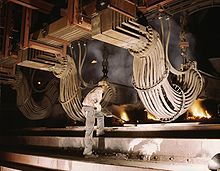
Back صهر (علم الفلزات) Arabic Шăрату CV Mwyndoddi CY Verhüttung German Fundición (metalurgia) Spanish گدازگری FA Extraction des métaux par calcination French Bruithniú GA היתוך (מתכת) HE प्रगलन HI

Smelting is a process of applying heat and a chemical reducing agent to an ore to extract a desired base metal product.[1] It is a form of extractive metallurgy that is used to obtain many metals such as iron, copper, silver, tin, lead and zinc. Smelting uses heat and a chemical reducing agent to decompose the ore, driving off other elements as gases or slag and leaving the metal behind. The reducing agent is commonly a fossil-fuel source of carbon, such as carbon monoxide from incomplete combustion of coke—or, in earlier times, of charcoal.[1] The oxygen in the ore binds to carbon at high temperatures, as the chemical potential energy of the bonds in carbon dioxide (CO2) is lower than that of the bonds in the ore.
Sulfide ores such as those commonly used to obtain copper, zinc or lead, are roasted before smelting in order to convert the sulfides to oxides, which are more readily reduced to the metal. Roasting heats the ore in the presence of oxygen from air, oxidizing the ore and liberating the sulfur as sulfur dioxide gas.
Smelting most prominently takes place in a blast furnace to produce pig iron, which is converted into steel.
Plants for the electrolytic reduction of aluminium are referred to as aluminium smelters.
- ^ a b "Smelting". Encyclopedia Britannica. Retrieved 23 February 2021.